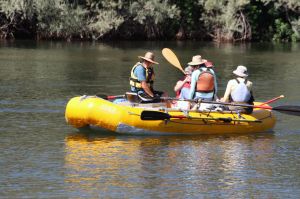AllCampgrounds Outdoor Adventures: Getting Started in River Rafting
Millions of people go camping around the U.S. every year, and we all have our favorite things to do outdoors. Some of the best tent camping anywhere is found on lakes and rivers, and getting out on the water can really help you enjoy camping to the fullest: just take a look at your favorite angler, getting up at dawn to find the best fishing spot, and you know what I mean!
But fishing is serene and quiet … what if you want a little more action? If you’ve never been rafting before, you might have a “Hollywood” vision of white rapids and a buff Stephen Seagal-type navigating some dangerous jungle river – but the truth is, with a little preparation, anyone can enjoy rafting at a range of skill levels. Today’s AllCampgrounds will tell you all about it.
Getting Started in River Rafting
Some of the best tent camping grounds anywhere are right on rivers, and no surprise; early nomads loved to settle down close to these excellent sources of water and fish, so their “camping” history is almost as long as their natural history. If RV parks and campgrounds are more your style, you’re still in luck: RV camps tend to be off the water, but you can always drive down there. The question is, what river do you need, and how should you prepare for your first rafting trip?
Rivers are rated from Class I to Class VI, with the Class I flows being calm, and Class VI being the stuff of Hollywood movies (well, approximately). Rafting has a reputation for danger, but Class I and Class II rivers are suitable for beginners, and plenty of family-oriented tour operators offer rafting under safe conditions. If you’re going to try it out on your own, you need two things: a raft and a crew. Of course, the size of your crew will determine the size of your raft; six people require about a 12-by-6 raft, and so on. Just like you wouldn’t go out onto the road with bad brakes or steering, the features of your raft go a long way to determining your safety and convenience.
Picking Your First Raft
Now, I’d suggest hooking up with a good rafting tour company for your first couple of excursions. It’ll help you learn whether rafting is right for you and give you starter techniques for rowing and navigation before you make the hefty investment for your own raft. You can also get a lot of good tips from experienced rafters during your trip. But sooner or later, you’ll be looking at rafts, so let’s talk about a few basic features.
Material: The most obvious feature is the material your raft is made of. The tradeoff here will usually be durability versus heft. Materials like nylon or cotton may wear out or tear in use, while synthetics and heavier materials can be heavy, hard to maneuver, and ultimately harder to repair; you may have to replace the raft completely.
Buoyancy: Buoyancy is largely determined by the size of the raft’s buoyancy tubes. Larger tubes mean better buoyancy, which can help prevent loss of control or capsizing in the water. Smaller tubes leave more room in the raft’s structure and generally translate to more responsive handling.
Safety features: Raft safety features vary considerably. No matter what the safety features of your raft, there’s some equipment you should definitely bring on every voyage: a waterproof flashlight, emergency light, safety whistle, and emergency rope. If forced to abandon your raft, these will help you get to safety as quickly as possible.
Other things to consider: Rafts can be difficult to sit and balance on without cross-tubes (called “thwarts”); these take up room, but provide more natural seating. Also consider how the raft will be packed, maneuvered to the waterfront, and inflated; a good pump is essential, and check out Army-Navy stores for suitable storage containers.


